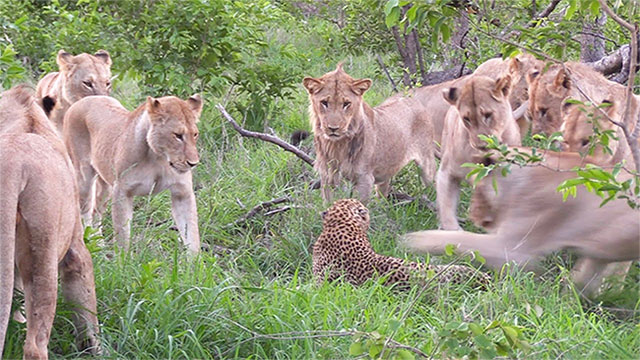A rare event was recorded at the Mala Mala Nature Reserve in South Africa when an adult leopard was surrounded and attacked by a pride of 12 lions.
In the video, it can be seen that the leopard seems to have sustained severe injuries to its hind leg, making it difficult for it to escape from its attackers.
The only thing it could do was to desperately fend off the fierce lions that were closing in and trying to bite it with their sharp teeth.
After a prolonged struggle, the leopard gradually became exhausted and succumbed to the pride of lions. As the unfortunate animal took its last breath, the lions quietly walked away without bothering to eat it.
The leopard (Panthera pardus), known in English as the “leopard,” is one of the five big cat species in the Panthera genus found in Africa and Asia. They range from 1 to nearly 2 meters in length and weigh between 30 to 90 kg. Females are typically about two-thirds the size of males.
Leopards have the largest distribution of all wild cat species, appearing widely across Africa as well as in East and Southern Asia, although their populations have shown a declining trend and are fragmented outside of Sub-Saharan Africa.

Despite being a powerful predator, leopards always have to flee from lions.
In the wild, despite being strong predators, they often have to compete for food and shelter with other predators such as tigers, lions, cheetahs, spotted hyenas, and even African wild dogs. These animals can steal the leopard’s prey, kill its cubs, or even kill adult leopards.
As a result, leopards survive by hunting a variety of prey and trying to avoid areas frequented by larger carnivores. Leopards can also actively retreat to trees in the face of direct attacks from other large predators, but on the other hand, they can kill or prey on competing rivals.
They also have a remarkable ability to adapt to different habitats, primarily associated with savannas and tropical forests. Leopard populations tend to thrive in any undisturbed areas within their range, including grasslands, open forests, and riparian woodlands.
In the Russian Far East, they inhabit temperate coniferous forests where winter temperatures can drop as low as -25 °C (-13 °F). They also adapt very well to some of the wettest tropical forests in the world and even the fringes of semi-arid deserts.


















































